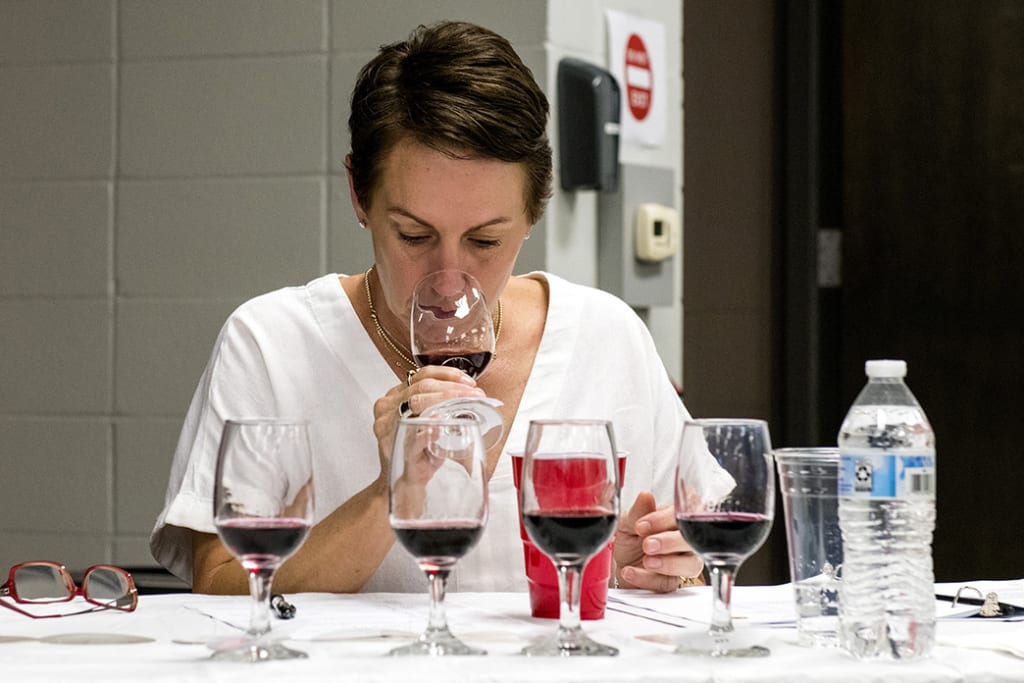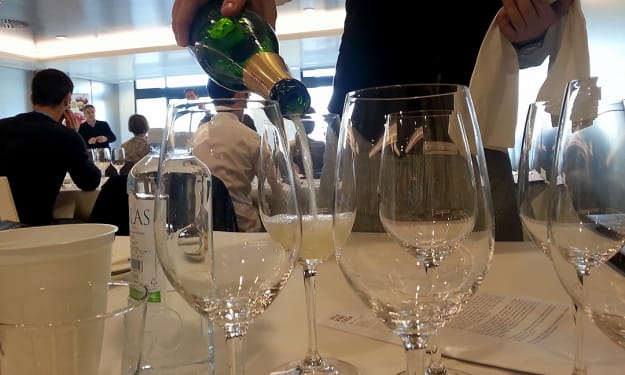What’s with all these weird wine words?
Descriptors made simple, or at least less ridiculous

Using words to describe wine is fraught with peril and and leaves wine writers exposed to ridicule. Adapting a line from Martin Mull: writing about wine is like dancing about architecture. And we do it anyway.
Many terms about wine tastes and smells are easy to understand, delicious to imagine.
Cherry, strawberry, raspberry, blueberry, plum, peach, pear, apricot, cranberry, lemon, lime, blackberry, red and blackcurrant, watermelon. We know those tastes and more from fruit we eat, and we can perceive them in the wine we drink.
Then, there are problematic descriptors. Minerals: like sucking on a rock. Who does that? Leather: do winemakers drop cowhides into their fermentation tanks? Green bell pepper: wait, I thought wine was made from grapes. What are those wine snobs talking about? Are they just making stuff up to appear superior to those of us who just want to sip something to complement a meal, maybe get a little buzz, maybe titillate the libido of a hot date?
The basics
Let’s start with the easy flavor and aroma notes related to fruits. Grapes are fruits and share the same complex chemistry with fellow fruits. During grape fermentation chemical compounds—esters—are created that are identical or nearly identical to those found in other fruits. When a wine is said to have cherry flavor or aroma, it is just as valid to say that a cherry has a wine flavor or aroma.
Secondary flavors spring from the winemaking process. Oak barrels impart notes from the oak. American oak tends to evoke vanilla and coconut notes, French oak hazelnut and smokiness. All oak can bring oak spice, clove, toasty notes, chocolate depending on how the barrel is made. Oak aging, which allows a slow intake of oxygen, makes wine smoother and less astringent while it adds its flavor and aroma notes.
Tertiary flavors develop with aging, in barrel, in stainless steel, in concrete eggs, and in the bottle. Those include earth, coffee, leather, and spices. In all these cases, the flavors and aromas are caused by the same—or nearly identical—chemical compounds found in the descriptors. As with fruit descriptors, it is just a valid to say this wine has aroma notes of leather as it is to say leather has aroma notes of a wine. The molecules presenting the sensation are the same or almost the same.

Weird descriptors
Okay. Wine shares the same molecules as familiar, pleasant tastes and smells. But what about the weird descriptors.
• Barnyard/sheep butt: Associated with pinot noir, particularly from Burgundy but also sometimes from elsewhere. It is an earthy scent often associated with quality—and it goes away with decanting or swirling in your glass. It should not be confused with “barnyard” associated with brettanomyces (brett), a yeast that invades wineries and can spoil wine (more about that later). So, there is good barnyard/sheep butt and bad barnyard/sheep butt. You want wine to be simple and easy?
• Farmyard: Associated with aged chianti. Kinder, gentler than “barnyard.” It describes earthy and vegetal undertones some wines develop. Like many such terms, used in admiration or deploration, depending upon the critic and the wine.
• Band-Aid: Smell associated with tempranillo and pinotage, usually means there is bit of brett (brettanomyces)—a yeast usually considered a flaw, but also considered a plus by some when it only slightly influences the wine. Different folks, different strokes. It mostly is associated with red wines. In low concentrations, it adds a spicy, leathery note. In higher concentrations, it ruins the wine.
• Wet wool/damp straw: Associated with chenin blanc. The aroma resembles lanolin, a fatty substance secreted by a sheep’s skin. The descriptor often occurs alongside mentions of honey, pears, lemon. Chenin blanc may be world’s most versatile grape—capable of almost any style. It is superb in Loire Valley of France. Want upscale? Ask for “Vouvray,” chenin blanc’s greatest appellation. Swirl, inhale, wistfully comment on its whisper of wet wool wafting amid notes of wild honey and lemons.
• Cat pee: Associated with sauvignon blanc, particularly from cooler climate makers in New Zealand and France-Sancere. It arises from natural compounds called pyrazines that give sauv blanc its grassy, herbaceous notes. When weak, sometimes called “lantana bush.” When stronger, “cat pee.” Again, a symbol of quality that will blow away with some air. So don’t meow. Say: “oui, oui, Sancere cat pee is for me.”
• Petrol/diesel: Associated with riesling. Aroma is not the smell you get filling your farm truck, but does suggest diesel or gasoline. It is caused by good-thing antioxidant TDN (1,1,6-trimethyl-1,2-dihydronaphthalene if you are a chemist geek), which forms from beta carotene and lutein as riesling ages. It is a distinguishing marker for those identifying riesling in blind tastings. It also blows away after exposure to air.
• Burnt rubber: Associated with syrah, also with South African wines. South Africans took umbrage when an English critic used the descriptor. “We prefer that people use the term acrid rather than burnt rubber,” averred a spokesperson for Wines of South Africa. Current descriptor preferred by wineries for this nose note: “sun-dried tomatoes.”
• Tar: Associated with nebbiolo (Barolo/Barbaresco) and syrah—means aromas and flavors reminiscent of tar. Who eats or smells tar to find out? Some claim it describes mix of meat and black pepper. Remember, smell is at least 75% of taste, so the “taste” of tar really is a slight—and slight is key—aroma of tar.
• Pencil shavings: Associated with cabernet sauvignon and petit verdot: hints of cedar or eucalyptus wood. Cigar box also associated with this nose nuance. Think of sharpening the #2 in the third grade. It is a mineral smokiness similar to graphite. Engendered either from tannins in the wine or the wine’s exposure to oak during the winemaking process.

Common wine terms
• Acidity: A key component of wines that “cleanses the palate” and affects how wine looks, tastes, and ages. The two main acids are tartaric and malic. Hot years/climates reduce acidity. Cold years/climates increase acidity. Acidity preserves freshness and keeps wines lively—very good thing. Too much acidity stomps on fruit flavors and texture—not a good thing. In tasting notes, “good acidity” often means it pairs well with food. Acidity especially is important in white wines and sweet wines.
• Ripe: Grapes achieve ideal level of maturity. Less-mature grapes produce lighter wines with less flavor and more acidity; over-mature grapes produce high-alcohol wines with less acidity. Ripe is the desired spot in the middle. Picking at perfect ripeness can be the most significant decision a winemaker makes in the vineyard.
• Rustic: Describes hearty, earthy wines and evokes visions of leather jackets and Harleys. Petite sirah and carignane celebrate being called rustic. Rustic tannins can be coarse and chewy, which your palate may or may not love. On other hand, if an expensive Burgundy is rustic, that is not a good thing. Wine cannot have silky, sophisticated tannins and be rustic at same time. If you like pleasure with a dollop of danger, rustic is good. If you prefer Maurice Chevalier over Clint Eastwood, rustic may not be the way to go.
• Round: Generally, means wines that have lost youthful, astringent tannins through bottle aging and/or oak aging. Also describes young wines with soft tannins and low acidity. Often associated with terms like velvety, creamy, plush, buttery. Generally, a good thing. Unless you lust for rustic.
• Soft: Round, fruity, low in acidity, no aggressive tannins, easy to drink; often associated with merlot.
• Earthy: Little girl with a curl—when good, very good; when bad, very bad. Good: fresh soil, intense expression of the land. Bad: barnyard after the cows finish eating. The chemical compound geosmin—a Greek name that translates as “earth smell”—is thought responsible, but the term is not about dirt, rather complexity and depth. Often is referenced in pinot noir, cabernet sauvignon, and syrah.
• Tannin: Tannins come from grape skins, seeds, and oak barrels. Tannin creates puckery, black tea-like sensation in your mouth that some people hate and others love. Tannic wines do well with fat-rich red meat because tannins cut through the fat on your tongue, enhancing the beef experience. Tannins also are key components of wine built for aging as they preserve the wine. Many tannic wines—Italian nebbiolo, for instance—are held in bottle for years before release to allow the tannins to mellow.
All tannins are not the same. Tannins are mostly characteristic of red wines than rather whites because most tannins come from the skins, stems, and seeds. White wines spend very little time on the skins, stems, and seeds, while red wines can spend weeks in contact. When tannins are harsh or aggressively drying, they are bad. When they are chewy or rustic, they can be good depending on your palate. When they are silky, integrated, smooth, round, lush, velvety, or supple, they are good, even if the writer cannot really tell you difference between round and lush or smooth and silky.
Dusty tannins are a special, Janus-faced category. Generally, dusty refers to tannic density. Dusty tannins may provide a pleasing background to fruit. Or they can be a drying note that steals flavor at the finish. Like many wine descriptors, “dusty” can just be a wine writer throwing adjectives against the wall.
• Structure: The balance of tannin, acidity, and alcohol, plus fruit and sugar level. Wines that lack structure are thin, flabby, disjointed, too tannic or too acidic. It is possible for a wine to have too much structure, usually because it is too tannic and out of balance with acidity and alcohol. Good structure, on the other hand, is a characteristic of high quality wines. Balanced structure allows wine to evolve over time in the bottle and develop more depth and complexity.
• Spicy: Various grapes contribute spice—syrah, zinfandel, petite sirah, malbec, grenache, gewürztraminer, riesling, and viognier are typically cited as being spicy. Oak barrels also impart spice. Common spice flavors are cinnamon, pepper, anise, clove, nutmeg, ginger, and mint. For most sippers, a slice of spice is a nice thing to encounter in the glass.
• Dry, Semi-dry, Sweet: Refers to amount of residual sugar. In broad terms, in dry wine, all the sugar was converted to alcohol; in sweet wine there is residual sugar; semi-dry falls in between. These are the general terms. Still wines and sparkling wines have different nomenclatures and more nuanced divisions. In still wines, going from driest to sweetest, the wines can be bone-dry, dry, off-dry, medium sweet, and sweet. In sparkling wines, going from driest to sweetest, the wine can be brut nature, extra brut, brut, extra-dry, dry, demi-sec, and doux.
Final thought
Wine descriptors—and their fellow partners in crime, wine scores—are inherently, patently imperfect, sometimes ridiculous. But we live in a chaotic world assaulted by a hurricane of choices. We rely on others to help separate the wheat from the chaff all the time. Recommendations from family and friends. Book reviews. Movie reviews. Restaurant reviews. Customer reviews.
And so it goes with wine. Can written words perfectly describe the experience you will have with a specific wine. Of course not, and every reputable wine writer knows that and will be quick to tell you that. In the best case, the words entertain you and give you some assistance as you face a wall of wine choices at your wine store, supermarket, or online seller. Imperfectly passing on knowledge and experience is the skill set that makes us humans.
Last round humor
• Someone once claimed a wine writer was a person with a typewriter who wanted a free lunch, free wine, and a way to write off his wine cellar on his taxes. That is a totally dated belief. Today, we use computers.
• “When it came to writing about wine, I did what almost everybody does—faked it” —Art Buchwald
• Wine is to women as duct tape and WD40 is to Southern men. It fixes everything.
• A glass of wine counts as a serving of fruit, right? Two glasses, two servings? Experts recommend 5-9 servings of fruits and vegetables daily. If the wine counts, I have this thing completely covered.
• Being asked if I want another glass of wine is like being asked if I would like more money.
• “The problem with Internet wine notes is it is so hard to verify authenticity.”—Tweet by George Washington, first president of the United States.
• Person with basement full of vodka: pathetic alcoholic. Person with basement full of wine: classy connoisseur and admired collector. Your life. Your call.
• After a few glasses of wine, do not tell people about your troubles. Half of them are not interested. The other half are happy you are getting what you deserve.
Contact information
Email: [email protected].
Newsletter: https://gusclemens.substack.com
Website: https://www.gusclemensonwine.com/
Facebook: https://www.facebook.com/GusClemensOnWine/
Twitter: @gusclemens
About the Creator
Gus Clemens
Nationally-syndicated humorist/wine writer. Gus appears in Gannett USA Today newspapers and several online platforms. Writing professionally since 1969, Gus has authored or participated in 20 books in addition to his humor/wine work.






Comments
There are no comments for this story
Be the first to respond and start the conversation.